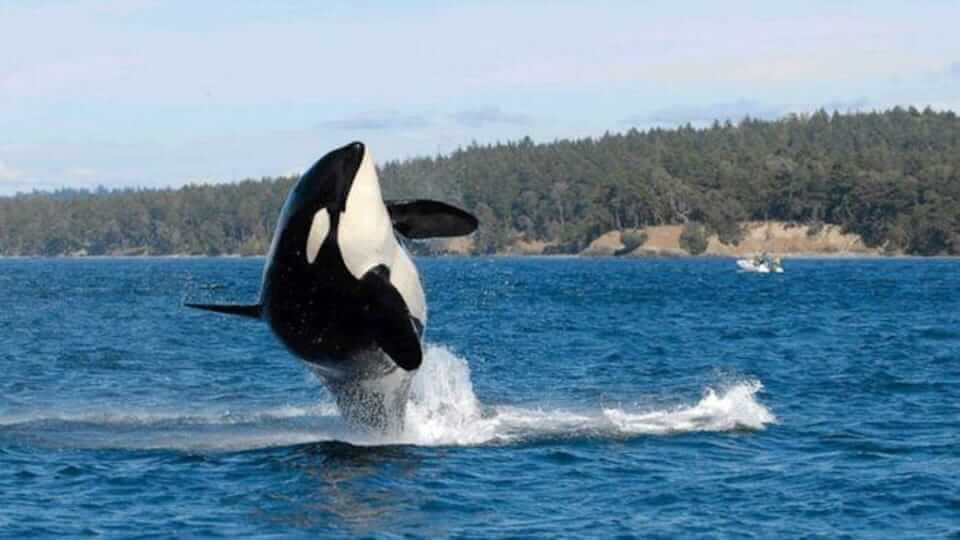Much like humans, killer whales can’t choose their family, but they can at least decide which of their little cousins they want to have fun with! This is what a recent study suggests that was prepared by a research group under the direction of Englishman Michael N. Weiss and published by the Royal Society. Researchers have shown that although resident killer whales of the Salish Sea are organized into family units, family members do not all interact with each other in the same way. It is believed that individuals of the same age and sex interact more with each other and that juveniles as well as females maintain a greater number of social relationships. To reach these conclusions, scientists observed killer whales using drones. Spying on the animals from above has greatly enhanced researchers’ understanding of associations and interactions within the population.
A matrilineal society
Known as “southern residents,” this killer whale pod inhabits the coastal waters of the northeastern Pacific, off the coasts of Washington state and British Columbia. The closely studied population of around 80 individuals has been the subject of an annual census since 1976. Since every individual in the pod is known and can be identified by its distinctive markings, the population was an ideal candidate for the study on social interactions.
Southern residents live in a society divided into matrilineal social groups. These small groups are made up of individuals that share a recent maternal ancestor and therefore represent family lineages. Those lineages with the most genetic links to each other come together to form larger, relatively stable social groups that share the same vocal dialect. In the southern resident population alone, there are three different dialects and several maternal lines.
Is association a sign of interaction?
Due to this “family” configuration, the majority of associations within the population are dictated by lineage, which means that individuals observed together are generally related matrilineally. An association takes place when two individuals swim in proximity to one another, while an interaction is a social behaviour that has a positive or negative impact on the quality of the bond maintained by two individuals.
According to Michael Moss and his team, just because a killer whale associates with its family doesn’t mean it can’t choose the individuals with which it interacts and forges the strongest social bonds. While the majority of previous studies took for granted that individuals that associated with one another also interacted, the researchers of the present study decided to distinguish the two in order to determine whether factors other than lineage (e.g. age and sex) might help create and maintain strong social relationships.
Looking down on a rumpus
The researchers first documented the synchronized ascent to the surface and simultaneous breathing of two individuals. This behaviour is important because it can promote cooperation as well as the maintenance of social relationships. They subsequently noted all physical contacts between individuals (with the exception of aggressive behaviours and those related to maternal care), as they often indicate a strong bond between two individuals and may also contribute to reconciliation following aggressive interactions. These two social interactions generally indicate peaceful relationships and can therefore help determine which groups of individuals are the most social.
By analyzing the occurrences of these two interactions in all individuals of the same social group, the researchers concluded that killer whales mostly tend to touch or breathe concurrently with other individuals of their age and/or sex. Just like at a family gathering, youngsters play together while parents mingle amongst themselves. The researchers also noted that interactions were mostly concentrated in two specific groups: juveniles and females. These groups are believed to represent the core of social networks and the ones that maintain the most bonds.
How did the research team manage to capture these fleeting moments of interaction? Using drones, the team tracked the killer whale population from above and managed to collect several hours of video footage. This is the first time that this population was studied using drones. The images therefore provide an unprecedented perspective on the social lives of these animals. However, this perspective remains limited to interactions occurring near the surface, as drone cameras cannot penetrate deeper, darker waters.
What about the males?
According to the researchers, male killer whales have fewer social ties because they are much larger and must therefore spend far more time hunting to meet their energy demands. Likewise, given that the dietary needs of juveniles are mainly met by their female caretakers, they likely have more time to devote to socialization. It remains to be seen how killer whales maintain pod cohesion despite the wide range of habits of their members.
Every species is unique
Physical interactions and contact between cetaceans are still poorly understood, but there appears to be no general rule. Sperm whales organize themselves into complex matriarchal societies, humpback whales produce extraordinary songs whose exact function is unknown, porpoises engage in collaborative hunting… And, in St. Lawrence belugas, the existence of allomaternal care and contact calls has been documented. And unlike killer whales, it is the males that are the most “touchy-feely”! “They depend on alliances to reproduce. It is in their best interest to invest time into developing their relationships and their skills,” explains Robert Michaud, director of the Group for Research and Education on Marine Mammals (GREMM). According to Michaud, the use of drones is set to revolutionize our knowledge of whales. “This is only a guess, but I believe the majority of social interactions in belugas takes place near the surface,” he hypothesizes. “I think they go to the depths to orient themselves, to listen, to feed… but not to socialize.” Thus, by carefully analyzing data obtained from the skies, we may be able to draw a fairly accurate portrait of the social lives of St. Lawrence belugas as well as killer whales in the Pacific.








